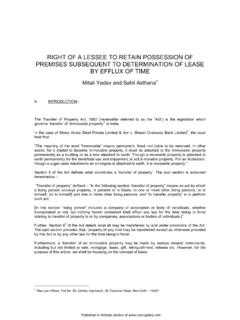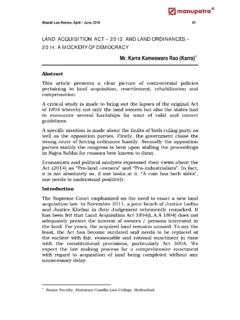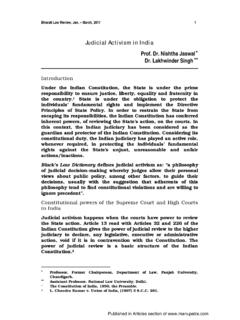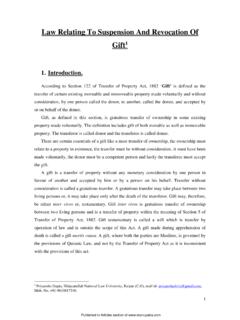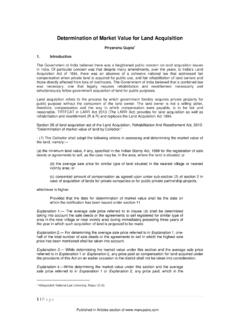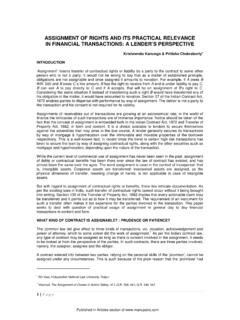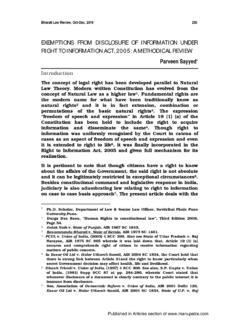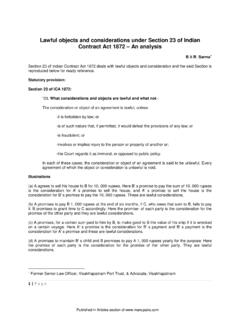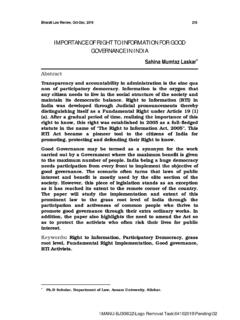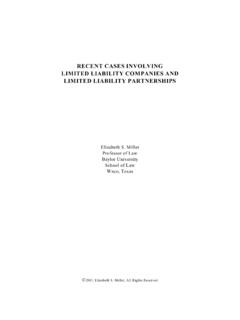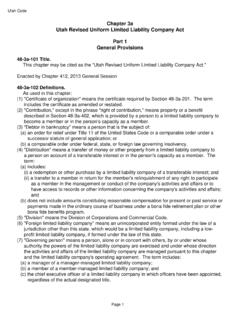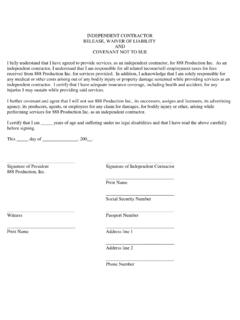Transcription of Absolute Liability: The Rule of Strict Liability in Indian ...
1 Absolute Liability : The Rule of Strict Liability in Indian Perspective Bharat Parmar & Aayush Goyal The present article is to analyse the long old principle of Strict Liability laid down in Ryland V Fletcher1 in year 1866 and its development in Indian perspective. The Article also emphasis on how the famous principle of House of Lords started a new era in the field of law of torts and its impact on Indian legal system and its evolution. Why, It is now required to modify it. And the various case laws and views of judges of Supreme Court of India on the Old principle.
2 Introduction The rule of Absolute Liability is similar to the rule of Strict Liability with some modification. This rule applies without any limitation or exception and creates a individual completely liable for any fault. The property to make anyone absolutely liable for the fault and imposition of high retraction make these Liability as Absolute Liability . The rule of Absolute Liability was laid down by the Honourable Supreme Court of India in the case of Mehta V UOI2 and Bhopal Gas Leak3 case. Where the Hon'ble Apex Court maximise the limit of rule of Ryland V.
3 Fletcher. The rule laid down by the SC is much wider with respect to the rule laid down by House of Lords. By Explaining the rule of No fault liability4 Blackburn J. said that "We think that the rule of the law is that the person who for his own purposes brings on his lands and collects and keeps there anything likely to do mischief if it escapes, must keep it in at his peril, and, if he does not do so, is prima facie answerable for all the damage which is the natural consequence of its escape."5 Need to modify the 19th century Rule The Modern position of Rule of Ryland V Fletcher The rule of Strict Liability6 was subject to many exceptions therefore practically very little ruled was left.
4 The old rule being with many exceptions was not capable to make any individual strictly liable for his negligence. Therefore it was essential to make harder rule with same purpose. Indian judiciary's View By analysing the need to modify the 19th century rule of Strict Liability the apex court of India in Mehta case stated that "Moreover the principle so established in Ryland v. Fletcher of Strict Liability cannot be used in the modern world, as the very principle was evolved in 19th century, and in the Bcom & BBA LLB 3rd Year (Batch 2013-18) Amity Law School, Jaipur.
5 1 1866 1 1868 3 HL 330 2 1987 SCR (1) 819 3 AIR (1989)(1)SCC 674: AIR 1992 SC 248 4 on Law of Torts 7th Edition 5 The Rule in Rylands v. Fletcher. Part I by Bohlen, Francis H. (1911). 6 The rule was formulated by Blackburn, J. in Exchequer Chamber in Fletcher v Rylands, (1866) 1 Ex 265 and the same was approved by the House of Lords in Rylands v Fletcher, (1868) 3 330. Published in Articles section of when the industrial revolution has just begun, this two century old principle of tortuous Liability cannot be taken as it is in the modern world without modifications"7.
6 Justice Bhagwati also stated that the rule of Strict Liability was evolved in 19th century, the time when nature industrial developments was at primary stage, in today s modern industrial society where hazardous or inherently dangerous industries are necessary to carry out development programme, thus this old rule cannot be held relevant in present day context. Also one cannot feel inhibited by this rule which was evolved in the context of totally different social and economic The Division Bench of Andhra Pradesh High Court also in the case of K.
7 Nagireddi V. Union Of India9emphasised the need to modify the old principle and expressed its view that "In India the general rule of Ryland V. Fletcher is accepted, though the principle is needed to be modified in its application to the Indian consideration." The term ' Absolute Liability ', as In his judgement, Blackburn , judge, referred the Liability as ' Absolute '. But the Liability in fact is Strict and in no way Absolute . The rule in Rylands v. Fletcher is subject to so many exceptions that in fact very little of the rule is recent trend is to limit the scope of the rule, and to bring it adjacent to the modern theory that there will be no Liability without any fault.
8 In view of these reasons, the term ' Absolute Liability ' is misnomer and the appropriate term is ' Strict Liability '11 Why the old Rule was inappropriate in Indian Perspective High Industrialisation Growth The Indian economy is highly developing economy. The Rule of Strict Liability is very old one. The Old Rule evaluates when there was very low industrial development so the old rule cannot be found appropriate in highly growing economy like India. Agriculture use of land In India the land is mostly used for land. Therefore it is appropriate to store the water in big tank for the purpose of irrigation.
9 The same thing do not prevails in the country from which it decided. Therefore it does not fit in Indian perspective. Very old rule not appropriate in present world The old rule was given in 19th century, about more than one 150 years ago, when the social and economical condition was totally different. Therefore it was necessary to make rule as per present requirement. Difference Between Strict Liability and Absolute Liability The difference between Strict and Absolute Liability rules was laid down by Supreme Court in Mehta v.
10 Union of India, where the court explains as: Firstly, In Absolute Liability only those enterprises shall be held liable which are involved in hazardous or inherently dangerous activities, this implies that other industries not falling in the above ambit shall be covered under the rule of Strict Liability . 7 Rogers, WINFIELD AND JOLOWICZ TORTS, 8th ed. 2010 pp. 248. 8 ibid MC Mehta case 9 AIR 1982 AP 119. 10 St Anne's well Browery v. Roberts. (1829) 141 LT at , per Scrutton, 11 Ibid Dr.
